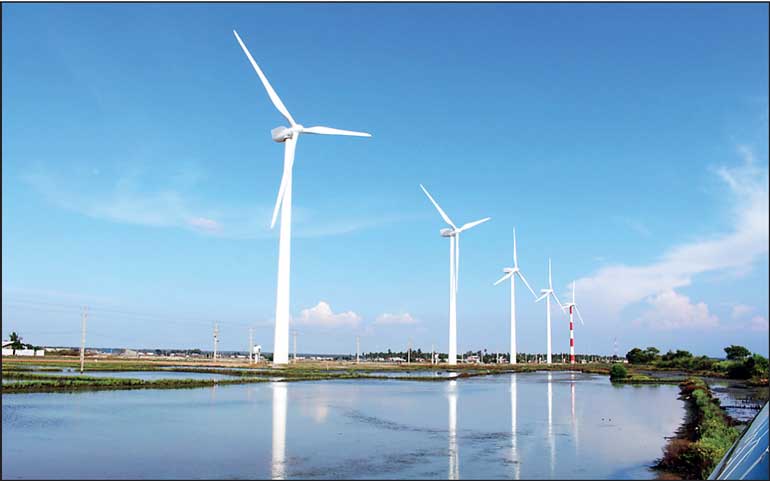Tuesday Dec 16, 2025
Tuesday Dec 16, 2025
Friday, 27 May 2022 00:20 - - {{hitsCtrl.values.hits}}

Just transition presents significant opportunities to mobilise resources, access support, and scale up sustainable economic growth
 Climate change presents an immense global challenge, especially given other threats and risks to economies and societies around the world. If humanity is to achieve the goals of the Paris Agreement, a just transition is necessary to mitigate climate change and build resilience on the national and local level. More than being necessary, however, a just transition also offers significant opportunities to mobilise resources, access support, and scale up sustainable economic growth and recovery for countries such as Sri Lanka.
Climate change presents an immense global challenge, especially given other threats and risks to economies and societies around the world. If humanity is to achieve the goals of the Paris Agreement, a just transition is necessary to mitigate climate change and build resilience on the national and local level. More than being necessary, however, a just transition also offers significant opportunities to mobilise resources, access support, and scale up sustainable economic growth and recovery for countries such as Sri Lanka.
Pathways of transformation
The concept of “just transition” was first introduced by labour unions and environmental justice groups and has become a mainstream aspect of addressing climate change. One of the early foundational documents comes from the International Labour Organisation, and issues surrounding just transition were addressed in the work on response measures under the United Nations Framework Convention on Climate Change as well as the 2015 Paris Agreement and the 2018 Silesia Declaration.
Just transition refers to the transformation of economies and societies toward environmental sustainability, decarbonisation, climate change adaptation, eradication of poverty, decent work, social inclusion, justice, and equity. There is no universally accepted definition but at its core, just transition is about leaving no one behind and providing safety for workers, their families, and communities. Key elements include institutional arrangements and policy coherence, including macroeconomic and labour market policies, social dialogue, skills development, occupational health and safety, and social protection. Furthermore, just transition is about utilising opportunities and choosing pathways of transformation that will provide decent work, access to sustainable finance, and resilience for all.
Opportunities of a just transition for Sri Lanka
What does a just transition look like in practice, particularly for developing countries such as Sri Lanka? It is highly context-specific and will look very differently depending on geographic area, sociocultural environment, and economic sector. For example, a just transition in the energy sector revolves around decarbonisation and a shift to clean and renewable energy, with everything that connects to this: power sources and fuel supplies, infrastructure and electrical grid, storage facilities, energy security, energy pricing, access to energy, restructuring of labour markets, cross-border trade and cooperation, subsidies and regulations, and financing mechanisms.
Similarly, a just transition in other sectors—for example food systems, transport, fashion and apparel, waste management, tourism, or construction—affects not just one aspect, but the entire up- and downstream supply and value chain as well as the communities and structures that have grown around them. It also connects to cross-cutting issues of gender, youth, vulnerable communities, the informal sector, and human mobility, particularly climate migrants.
Climate change mitigation as well as adaptation can secure existing jobs, create new employment opportunities, lead to the reinvention of regions, and provide incentives to develop green skills and technologies. However, there is also a danger that economic changes result in unemployment, loss of livelihoods, reduced productivity and competitiveness, stranded assets, social inequality, degradation of social cohesion, and other adverse impacts. For this reason, it is vital that transition in any sector is properly managed and guided through policies, social protection systems, long-term planning, and an adaptative risk management framework.
Early action on just transition can significantly minimise negative outcomes and maximise the benefits offered by transformation, such as the creation of new green jobs with good working conditions, education and skill development programs leading to an improved workforce, and an upswing in innovation and entrepreneurship. There is no solution or strategy that fits every sector or community, but there is an overarching need for a coordinated, efficient, and inclusive just transition.
Funding a just transition
Finance plays a critical role for this process from three perspectives. First, large-scale funding and resources—including technology transfer and technical support—are needed to implement an effective just transition in developing countries. Second, the financial sector itself must incorporate a just transition logic into its operations, foster a new financial ecosystem, and transform itself to provide capital and risk-sharing mechanisms. Third, planning and implementing a just transition can also be a way to attract additional funding and investment, which can accelerate the economic transformation and stimulate growth.
Such just transition finance can come from different sources, include public, multilateral, private, and philanthropic ones. Examples of public multilateral finance include the climate and environment funds set up by the United Nations (Green Climate Fund, Adaptation Fund, Global Environment Facility), development funds, or multilateral development banks. Private finance for just transition can come from impact investment, green bonds, venture capital, angel investors, or corporate social responsibility measures. Potential other sources could include blended finance that combines public and private funding, carbon markets, payment for ecosystem services, or insurance schemes.
The notions of “one size does not fit all” and “leave no one behind” are at the heart of just transition and directly link to key principles of climate action, sustainable development, and social justice. Education curricula, training programmes, greenskilling, technology transfer, innovation, and new business practices are all elements that need to be combined with social dialogue, safety nets, and societal changes to achieve equitable and lasting transformation.
Investment from the public and private sectors is required to address the climate crisis and support economic recovery, growth, and transition. With a roadmap, a long-term plan, and a robust policy environment, the concept of just transition can be a cornerstone for the mobilisation of such investment.
(The writer works as Director – Research and Knowledge Management at SLYCAN Trust, a non-profit think tank based in Sri Lanka. His work focuses on climate change, adaptation, resilience, ecosystem conservation, just transition, human mobility, and a range of related issues. He holds a Master’s degree in Education from the University of Cologne, Germany and is a regular writer to several international and local media outlets.)